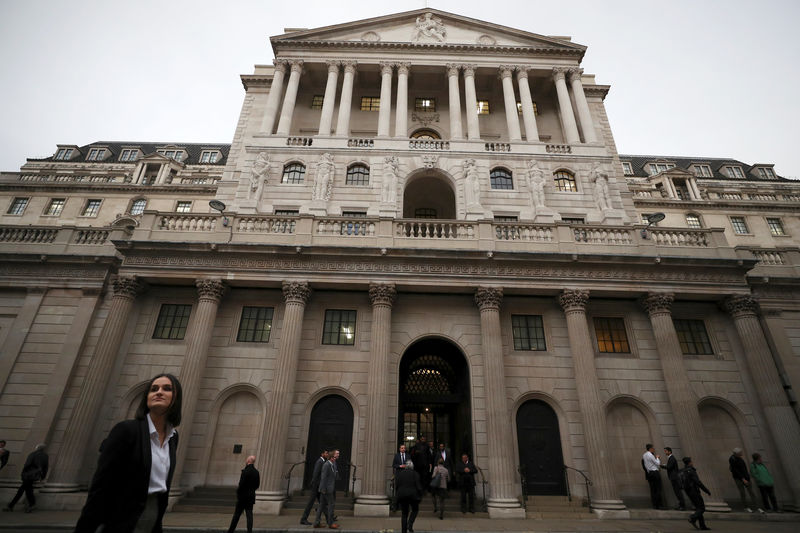 © Reuters. People walk past the Bank of England in London
© Reuters. People walk past the Bank of England in LondonBy Andy Bruce and Saikat Chatterjee
LONDON (Reuters) – The Bank of England has a problem.
It is poised to raise interest rates for the first time in a decade on Thursday, with the hike expected to be from 0.25 to 0.5 percent. But many investors in British assets and economists are skeptical this will mark the start of a cycle of “limited and gradual” rises, as the BoE has been signaling since 2014.
They are instead betting the uncertainties surrounding Britain’s exit from the European Union and fundamental weaknesses in the British economy will hinder any plan to pursue a cycle of rate rises, no matter how gradual.
Marc Ostwald, market strategist at ADM Investor Services, said the market expectations for rate rises was best summed up as “one and done”. He added the bank and its Governor Mark Carney had put themselves under undue pressure with their own recent guidance on rates.
“The BoE has painted itself into a corner,” he said.
Carney thinks leaving the EU will reduce the speed limit on how fast the economy can grow without pushing up inflation, which has hit a five-year high of 3 percent, above the BoE’s 2 percent target.
In other words, higher rates will be needed even if growth is weak, although they are unlikely to return to pre-financial crisis rates of around 5 percent for the foreseeable future.
While many investors accept his logic in principle, they say it is impossible to look beyond the hard data available now which shows a lackluster economy and the likelihood of more turbulence from Brexit negotiations.
“We think the UK economy is in a structurally weak place … and as such further rate hikes after this week look very difficult,” said Nick D’Onofrio, managing partner at North Asset Management, a hedge fund in London with around $500 million under management.
He cited Britain’s current account deficit – the largest among major advanced economies last year – as a vulnerability.
“We would look to sell sterling into any post BoE-rate hike bounce,” D’Onofrio said.
BALANCING ACT
Financial market expectations for interest rates, measured by overnight index swaps, assign an almost 90 percent chance of a 25 basis-point hike on Thursday.
But after that, the chance of a further 25 basis-point increase stood on Tuesday between 30 and 38 percent for 2018, Ostwald said.
He thinks Carney has left himself a tough task to explain the BoE’s future intentions for rates.
If the BoE does hike this week, the governor faces a precarious balancing act: he will want to reassure the public that borrowing costs are not set to rise sharply, without encouraging complacency in markets that rates will stay super-low.
Investors were surprised in September by a marked escalation in tone from the BoE’s Monetary Policy Committee (MPC), most of whose members felt a hike would probably be needed “over the coming months” if the economy and price pressures continued to grow.
Markets had not been expecting a rate rise before 2019 but shifted fast to focus on November. A change in tone from the BoE on Thursday could cause further shifts.
Almost all economists polled by Reuters last week expect the BoE to raise rates on Thursday. But most do not expect another one next year: the poll’s consensus shows the rate is likely to be stuck at 0.5 percent until mid-2019. Seventy percent said even one rate rise now would be a mistake. [BOE/INT]
The latter view is common in markets, too.
Carney may struggle to get his message about future rate hikes through to investors who are worried about the progress of Brexit talks above all else.
“We are about to see the largest economic adjustment the country has seen in decades and the BoE is tightening policy into that,” said Russell Silbertson, head of Multi-Asset Absolute Return at Investec Asset Management in London.
He has trimmed his sterling positions after the pound’s recent rally.
“Given that households are leveraged up and the economy is weak, we remain skeptical about (the BoE’s) optimism,” he said.
FORWARD GRIEVANCE
The BoE has long been criticized for its efforts to steer market expectations for interest rates, a policy called forward guidance introduced in 2013.
Under Carney the BoE has made a habit of signaling higher rates and then being unable to deliver them.
“It does look as if people have not received the Bank’s attempts (at forward guidance),” said former BoE deputy governor Rachel Lomax, speaking at a monetary policy discussion organized by economic research firm Fathom Consulting on Tuesday.
Lomax, an MPC member for five years until 2008, recalled debates about the merits of forward guidance.
“People who were against it always said no-one will ever understand that it’s conditional, we will just look like fools and so on,” Lomax said. “Maybe the naysayers were right. But I give Mark basically credit for trying.”
Other economists are less forgiving.
Erik Britton, Fathom Consulting’s managing director, said Carney faced a no-win scenario on Thursday.
“I think there’s a high likelihood that they’re going to trip over their own forward guidance,” he said.
“Either way, he’s going to look a bit silly. Because even if they (hike rates), people will judge it unnecessary. Or if they don’t do it, people will say ‘what on earth was that forward guidance about?'”
Source: Investing.com




























